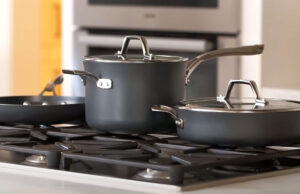As an Amazon Associate, I earn from qualifying purchases at no extra cost to you.
How to Secure Bosch Dishwasher to Cabinet Like a Pro
You open your kitchen door, and your Bosch dishwasher wobbles a little. Ugh, that annoying shake! It’s not only irritating but can cause leaks or damage over time. In this article, we’ll fix that. You’ll learn the easiest ways to make your dishwasher sit snug, steady, and safe.
First, check the dishwasher alignment and cabinet space. Next, gather the right tools like a screwdriver, brackets, and measuring tape. Focus on stability and proper attachment points to prevent tilting or vibration. Tighten carefully but not over-aggressively to avoid damaging surfaces.
Check and Prepare Your Dishwasher and Cabinet Space
Before touching any screws, take a moment to inspect your dishwasher and the surrounding cabinets. Make sure the area is clean, free from debris, and level. Uneven floors or misaligned cabinets can make your dishwasher unstable, so a quick check saves headaches later.
Measure the space carefully. Bosch dishwashers usually fit a standard width, but cabinets can vary slightly. Keep in mind any plumbing or electrical connections. Sometimes hoses or cords can get caught if the dishwasher isn’t placed correctly. Clear the path and remove obstacles.
Also, look at the dishwasher’s sides and top. Bosch units often have built-in brackets or mounting points. Identify them before starting. Knowing where the screws or bolts will go helps you avoid guesswork and accidental scratches on the cabinet.
Finally, consider a helper. Having someone hold the dishwasher while you secure it makes the process safer and smoother. This little extra step can prevent frustration and mistakes, keeping your kitchen intact.
- Ensure area is clean and level
- Measure space carefully
- Identify mounting points on dishwasher
- Clear plumbing and electrical obstacles
- Consider getting a helper
Align the Dishwasher Properly in the Cabinet Opening
Proper alignment is crucial to prevent wobbling. Slide your Bosch dishwasher gently into the cabinet space. Keep checking that it sits evenly from front to back and side to side. Misalignment here can make securing it later nearly impossible.
Use a level tool on top and sides of the dishwasher. Tiny adjustments matter—dishwashers are heavy, and even a small tilt can cause doors to swing incorrectly or water to leak. Move the feet if necessary to adjust height.
Pay attention to the cabinet face. The dishwasher should sit flush, not sticking out or recessed. This makes it easier to attach brackets and keeps your kitchen looking neat. Sometimes, a shim under the feet can correct minor gaps.
Double-check surrounding edges. Make sure there’s enough space for hoses and power cords without pinching them. Proper alignment now means a secure fit later, saving you from tightening and loosening screws repeatedly.
- Slide dishwasher gently into space
- Use a level to check alignment
- Adjust feet or add shims if needed
- Keep dishwasher flush with cabinet
- Ensure hoses and cords are clear
Secure the Dishwasher Using Top or Side Mount Brackets
Bosch dishwashers usually come with mounting brackets to attach to the cabinet. Decide whether top or side mounting works better for your setup. Side mounting is common if the countertop has a gap, while top mounting suits solid countertops.
Start by holding the bracket in position. Use a pencil to mark screw holes on the cabinet. Then, drill pilot holes if needed. This prevents splitting the wood and ensures screws go in straight. Tighten screws until snug but avoid over-tightening to protect the cabinet and dishwasher.
Check stability after each bracket. Gently push the dishwasher from different angles. If it moves or tilts, adjust the bracket slightly. Sometimes you need to slightly reposition the screws to get a firm hold without stress on the metal.
Once the brackets are secured, double-check the dishwasher’s level. A small tilt can affect door operation and water drainage. Adjust the feet or brackets slightly if needed. A perfectly secured dishwasher gives confidence and prevents noisy vibrations while running.
- Choose top or side brackets
- Mark screw holes and drill pilot holes
- Tighten screws carefully
- Test stability after each bracket
- Check dishwasher level
Connect Water Supply and Drain Lines Safely
Before pushing the dishwasher fully in, connect the water and drain lines. Turn off the main water supply first to avoid leaks. Attach the water inlet hose to the dishwasher and ensure it’s tight, but not forced.
Next, connect the drain hose. Ensure it has a proper loop or height to prevent backflow. Secure it with clamps if necessary. Avoid sharp bends or kinks that could block water flow. Check that hoses don’t press against the cabinet or floor.
After connecting, turn on the water supply and watch for leaks. A tiny drip can become a bigger problem over time. Tighten connections slightly if needed, but don’t overtighten plastic fittings. Safety and proper sealing are key.
Finally, plug in the dishwasher. Ensure cords are away from water and won’t get pinched when sliding the unit fully in. This step completes the functional part, keeping both water and electricity safely managed.
- Turn off water supply
- Attach water inlet hose securely
- Connect drain hose with proper loop
- Check for leaks
- Ensure cords are safely placed
Test Dishwasher Operation Before Final Adjustment
Run a short cycle with the dishwasher empty to test everything. Listen for unusual noises, check for vibrations, and watch for leaks. Testing early helps catch problems before the dishwasher is fully locked in.
Check the door alignment. It should open and close smoothly without rubbing the cabinet. If the door hits the frame, minor height adjustments or bracket tweaks can fix it.
Observe water drainage. Make sure water flows correctly into the drain hose without pooling. Even small puddles indicate misalignment or kinks in the hose. Address these issues immediately.
After testing, make any last adjustments. Tighten brackets slightly if necessary and ensure the dishwasher remains level. Once everything runs smoothly, push the dishwasher fully into place. Proper testing prevents surprises later.
- Run empty cycle for testing
- Check for noise and vibration
- Ensure door opens smoothly
- Observe water drainage
- Adjust brackets or height as needed
Final Checks for Safety and Stability
Take one last look around your Bosch dishwasher. Ensure it’s level, brackets are tight, hoses are clear, and the unit is flush with the cabinets. A final inspection saves stress later.
Check the countertop connection. If using top-mount brackets, ensure they are firmly screwed to prevent movement. Side mounts should also be re-checked for tightness. Small shifts can occur during testing.
Inspect the floor under the dishwasher. Look for water leaks or wobbling spots. Even a slight tilt can lead to long-term problems. Adjust feet or brackets as needed to make it rock-solid.
Finally, step back and admire your work. A securely installed dishwasher not only works better but gives peace of mind. The kitchen looks neat, and you can run cycles without worry or noise.
- Ensure dishwasher is level and flush
- Re-check brackets
- Inspect for leaks or wobble
- Adjust feet if necessary
- Confirm everything feels solid
| Task | Tools Needed | Tips | Common Mistakes |
|---|---|---|---|
| Measure space | Tape measure | Check cabinet width carefully | Assuming standard fit |
| Align dishwasher | Level | Adjust feet for level | Ignoring uneven floors |
| Mount brackets | Screwdriver, screws | Drill pilot holes | Over-tightening screws |
| Connect hoses | Wrench, clamps | Avoid kinks | Pinched hoses |
| Test operation | Dishwasher cycle | Listen for noise | Skip testing |
| Final check | Level | Tighten all screws | Miss small adjustments |
Frequently Asked Questions (FAQs)
Is it necessary to use both top and side brackets for Bosch dishwashers?
No, it isn’t always required. Bosch dishwashers can be secured using either top or side brackets depending on your cabinet and countertop setup. Top mounting is typically used if you have a solid countertop above the dishwasher, providing extra stability. Side mounting works if there is a small gap or if top mounting isn’t practical. Using both can add stability but is generally overkill. It may also make installation harder, especially in tight spaces. Make sure the chosen method secures the dishwasher without forcing screws or damaging surrounding cabinetry.
Can I install a Bosch dishwasher without a helper?
Yes, it’s possible, but having a helper is highly recommended. Dishwashers are heavy and awkward to maneuver, and a second person can help hold it level while you secure brackets. Installing alone increases the risk of scratches, misalignment, or pinched hoses. If you must do it solo, consider using a sturdy towel under the front edge to slide it slowly. Take extra care with leveling and bracket installation. Patience and steady hands are key, and you should never rush through connections for safety reasons.
Do I need special tools for securing a Bosch dishwasher?
Not really. Most installations require basic tools like a screwdriver, wrench, level, tape measure, and sometimes a drill for pilot holes. Bosch dishwashers come with mounting brackets that fit standard screws. Avoid makeshift tools that can strip screws or damage the dishwasher. A small wrench helps tighten water connections, and clamps secure the drain hose. Using the right tools ensures safety, proper alignment, and prevents damage to cabinets or the dishwasher itself.
Is it normal for the dishwasher to wobble slightly after installation?
A slight wobble is normal initially, but it should disappear after adjusting the feet and tightening brackets. Any persistent wobble indicates the dishwasher isn’t level or brackets aren’t secure. Check the floor, alignment, and mounting screws. Adjusting the height of the front or rear feet often fixes most movement. Ensuring hoses aren’t pinched and cables are clear also prevents pressure that could cause shifting. Proper alignment from the beginning reduces long-term noise and wear on components.
Can I use a Bosch dishwasher on an uneven floor?
Yes, but extra care is needed. Uneven floors can cause doors to misalign and affect water drainage. Adjusting the dishwasher feet can compensate for minor unevenness. For significant unevenness, consider using shims or leveling platforms. Always check that brackets are firmly attached and the unit doesn’t tilt forward or backward. Testing with an empty cycle helps verify stability. Skipping these adjustments can lead to leaks, noise, and long-term damage to the appliance.
Do I need to worry about water leaks when securing the dishwasher?
Absolutely. Even a small leak can damage cabinets or flooring over time. Always ensure the water inlet and drain hoses are securely connected and free from kinks. Tighten fittings just enough to prevent leaks without cracking plastic connectors. After installation, run a short test cycle to confirm no water escapes. Check under the dishwasher and around connections. Re-tighten if necessary and ensure hoses are positioned safely, avoiding any pinching that could cause future leaks.
Is it okay to overtighten the bracket screws?
No, overtightening screws can damage cabinets, dishwasher metal, or warp surfaces. Tighten until snug, then test stability. If it still moves, slightly reposition screws rather than forcing them. Brackets should hold the dishwasher firmly without stressing the surrounding wood. Using pilot holes also helps prevent splitting and ensures a straight, secure fit. Balanced tension provides stability and prolongs both cabinet and dishwasher life, preventing creaking or wobbling during operation.
Can I adjust the dishwasher after it’s fully installed?
Yes, minor adjustments are possible. Loosen brackets slightly to reposition, adjust feet for leveling, or correct door alignment. Always make sure the dishwasher remains secure while adjusting. Avoid pulling or forcing hoses, and recheck connections to prevent leaks. Testing with a short cycle after adjustments ensures everything functions correctly. Small tweaks after initial installation are normal and help achieve perfect alignment and quiet operation.




